

Only 3 out of 10 employees think performance reviews at their workplace are fair. At the same time, 70% of companies' HR are rethinking how they manage performance. Why? Because outdated or unclear review processes leave employees confused about how they’re doing and where they’re headed.
Using a performance review template can make a big difference. It gives managers a clear format to follow, helps employees understand their progress, and shows how their work supports the company’s goals.
For example, instead of just saying “good job,” a manager using a template might rate an employee’s communication skills, give examples from the past quarter, and suggest one area to work on for the next review.
In this article, we’ll explain:
What a performance review is
How to measure employee performance
How to create a simple, customizable review template for your team
A performance review is a formal process where a manager evaluates how well an employee has been doing their job. It’s also a chance to set goals for the future — goals that match both the employee’s personal growth and the company’s overall direction.
These reviews usually happen once a year, twice a year, or every quarter, depending on the company.
In most cases, an employee’s direct manager leads the performance review. They know the employee’s daily work and progress best. Meanwhile, the HR team helps guide the process by:
Creating templates and review forms
Training managers on giving useful feedback
Reviewing the results across teams to improve future reviews
A good performance review helps:
Give clear and helpful feedback
Show where the employee can improve
Define their role and responsibilities better
Keep them motivated and focused
Support their career growth
In short, performance reviews help employees improve, and when employees grow, the business grows too.
According to Gallup, only 30% of employees believe their reviews are fair. But when done well, regular feedback can make a big difference:
Employees who get regular feedback are 4 times more likely to be engaged at work
Fair and thoughtful reviews help build trust and reduce staff turnover
Feedback that focuses on development can lead to higher job satisfaction
Example: Instead of just saying, “You need to do better,” a manager might say, “Your last two client reports were detailed and well-written. Let’s aim to meet deadlines a bit earlier next quarter.”
A strong performance review template helps make the review process clear, fair, and useful. Here’s what to look for:
Clear and measurable: Uses specific goals, ratings, or examples to show how someone is doing.
Goal-oriented: Encourages setting new goals and creating a plan for growth.
Fair and consistent: Applies the same standards to everyone, no matter their role.
Balanced: Points out what the employee is doing well and where they can improve.
Future-focused: Connects the employee’s goals with the company’s direction.
Flexible: Works for different job roles, performance levels, and company styles.
Easy to understand: Uses simple language and focuses only on what matters most.
Private and respectful: Keeps employee feedback confidential and supports open, honest conversations.
Simple to use: Easy for both managers and employees to fill out and follow.
Well-designed: Clean layout and organized sections make it easier to read and complete.
Review your team’s performance effortlessly with these 10 simple, printable employee performance review templates — all easy to use and ready to customize.

Download: PDF | Google Docs | Word
An annual performance review is done at the end of the year to look back on what the employee has accomplished and what they can improve on.
This template usually includes:
A list of goals set at the start of the year, marked as achieved or not achieved
The employee’s key strengths
Areas for improvement to focus on in the coming year
It helps managers give a full-year summary and set the direction for future growth

Download: PDF | Google Docs | Word
Quarterly reviews help you stay on top of employee progress throughout the year. They make annual reviews easier by keeping things on track and avoiding surprises.
This template covers:
Goals that were met and those that weren’t
How well the employee solves problems and stays organized
Teamwork and collaboration
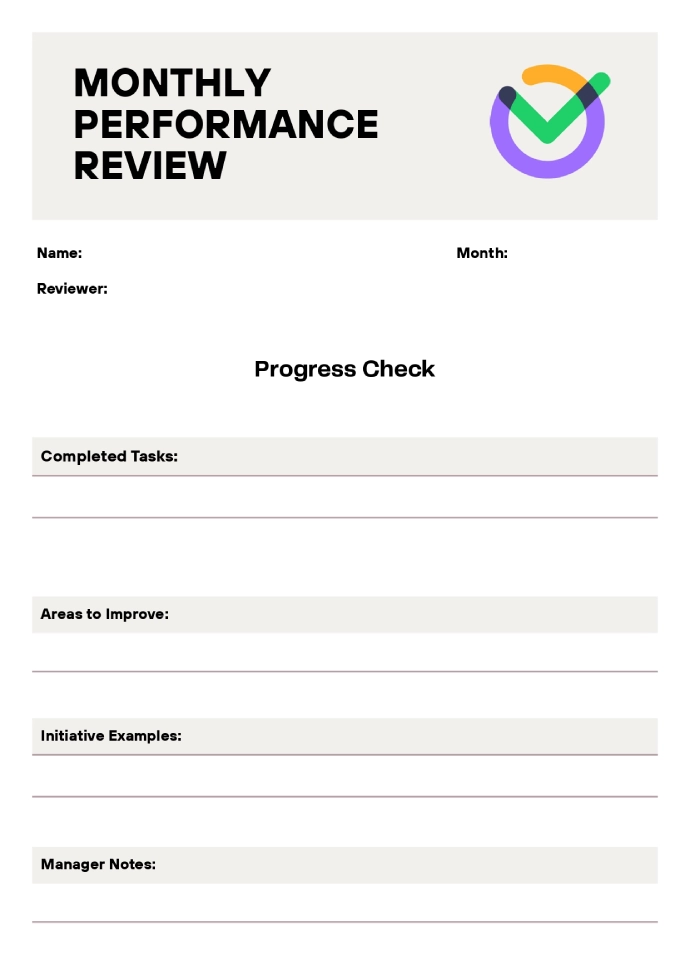
Download: PDF | Google Docs | Word
Monthly reviews are ideal for new employees or team members who’ve recently moved into a new role. Since they’re still getting settled, these reviews offer more frequent feedback and guidance.
This template includes:
Goals completed during the month
Areas where the employee can improve
Examples of initiative and creativity
It’s a simple way to check in regularly and support their early growth.

Download: PDF | Google Docs | Word
This template uses numbers to rate an employee’s performance, making it quick and easy to review and compare. It includes key areas like:
Teamwork
Leadership
Creativity
Willingness to learn
Each skill is rated on a scale from 1 to 5, based on how well the employee performs in that area. This type of review is great when you need a clear, simple overview or want to compare performance across team members using a consistent scoring system.

Download: PDF | Google Docs | Word
This template lets employees reflect on their own performance and share how they view their work and progress. It gives you valuable insight into their mindset and motivation.
The template includes open-ended questions about:
Personal achievements
Career goals
Challenges faced
Overall job satisfaction
When combined with feedback from managers and coworkers, this self-evaluation helps create a more complete and balanced view of the employee’s performance.
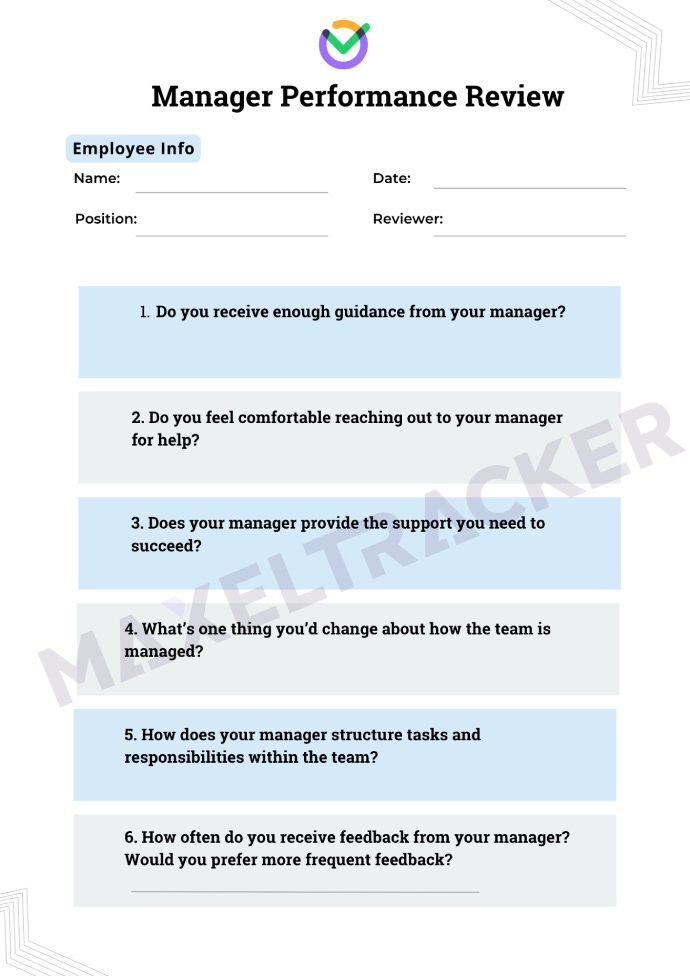
Download: PDF | Google Docs | Word
This template is designed to gather feedback on a manager’s leadership and management style. It uses open-ended questions to evaluate how well they:
Give feedback
Support their team
Handle conflict
Organize tasks and projects
The review is anonymous, so team members can share honest opinions without concern. It helps identify how managers are performing and where they can grow as leaders.
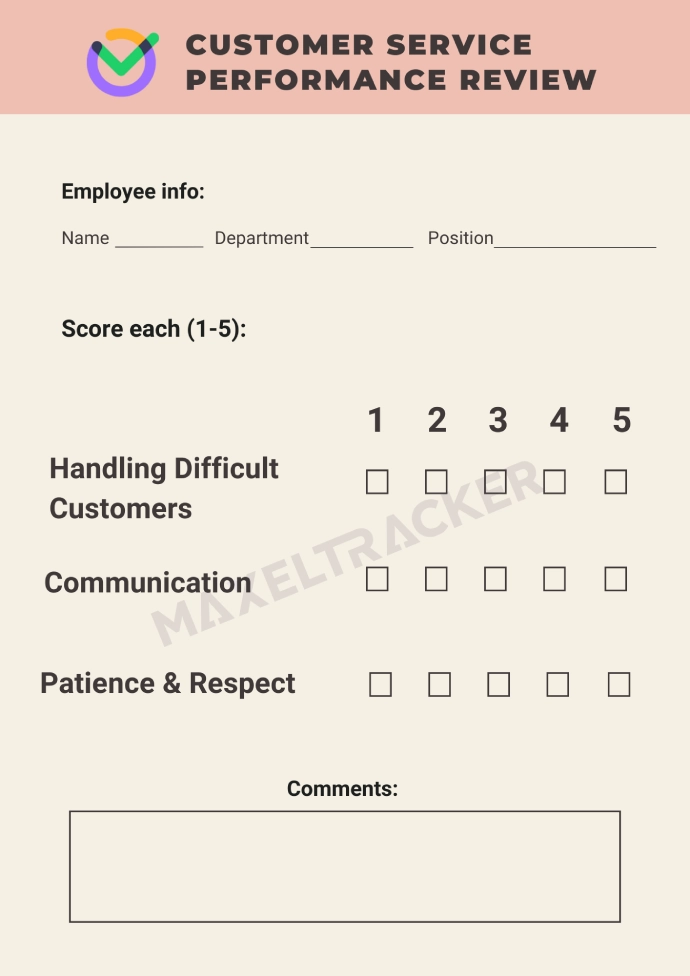
Download: PDF | Google Docs | Word
This template is made for employees who work directly with customers. It rates how well they handle different situations and treat clients.
Key areas include:
Handling difficult customers
Showing respect and patience
Each area is scored from 1 to 5, and there’s space at the end for extra comments or notes. This review is ideal for customer support, sales, and any team focused on keeping customers happy.

Download: PDF | Google Docs | Word
This template helps you check how a new hire is settling into their role and your company.
Even in the early stages, you can assess important areas like:
How well they completed the onboarding process
How they’re fitting in with the team
Whether they meet deadlines
Their willingness to learn and pick up new skills
It’s a useful way to spot early strengths and offer support where needed.
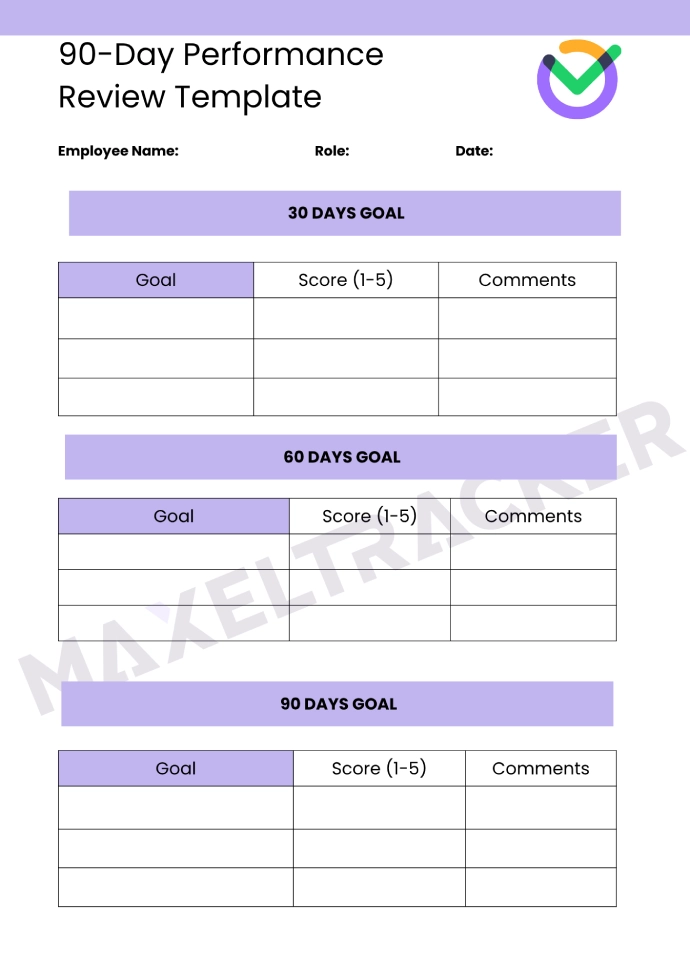
Download: PDF | Google Docs | Word
This template follows the 30-60-90 day plan often used for new hires. It helps track how well a new employee is meeting the goals set for their first three months.
The template includes:
Three sections for 30, 60, and 90-day goals
A 1–5 rating scale for each goal
Space for comments and feedback
It’s a great way to check progress, offer guidance, and support employees as they settle into their role.
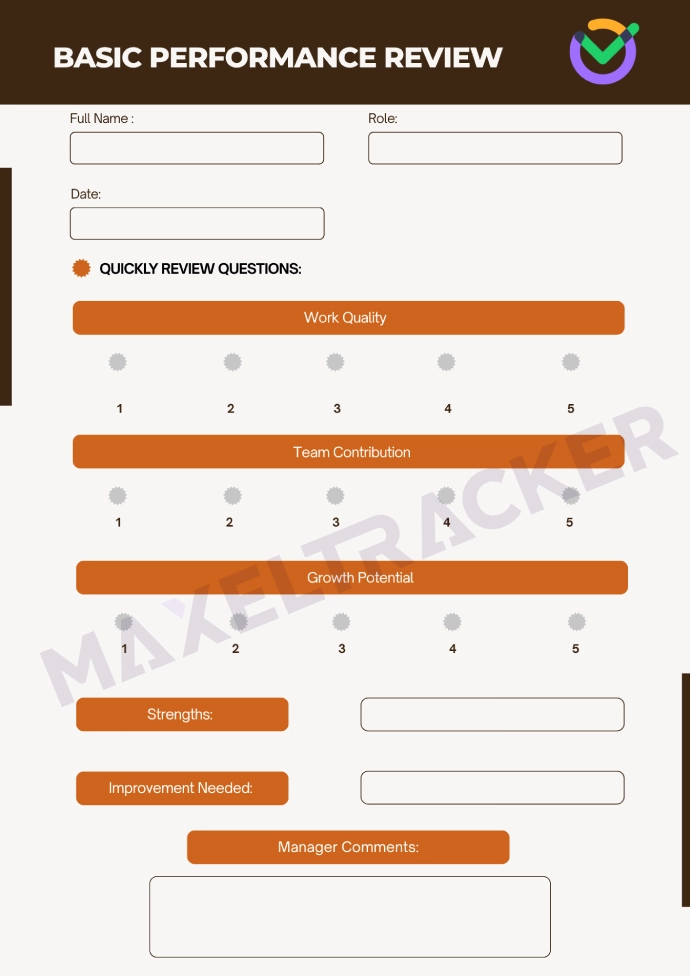
Download: PDF | Google Docs | Word
It includes:
Questions about skills, teamwork, and growth potential
Sections for strengths and areas where improvement is needed
The best part? It’s flexible and can be used anytime to help managers stay updated on how employees are doing and where support might be needed.
If you're creating a performance review template for your team or company, here are the key things to consider:
There are different ways to conduct a performance review, and the format you choose should match the employee’s role and your company’s culture. Here are some common types:
Self-evaluation: Employees review their own performance. This helps them reflect on their work and share their own perspective.
Manager-led review: A manager evaluates the employee's performance. This is one of the most common formats.
360-degree feedback: The employee is reviewed by peers, managers, and sometimes even clients. It gives a more complete picture.
Combination: Some companies use both self-reviews and manager feedback to create a more balanced evaluation.
Many businesses are moving away from paper reviews and using digital forms instead. With digital templates, you can:
Fill in performance details before the meeting
Add goals and comments during the discussion
Keep records safe and organized online
"Competencies" are the skills, behaviors, and qualities you want to evaluate. These should match both:
The responsibilities of the employee’s role
The goals and values of your company
For example, if teamwork is a big part of your culture, you should include it as one of the criteria. If creativity is important in a role, make sure it’s on the list.
This ensures the review focuses on what actually matters for success in the company.
Your review template should start with a section that captures basic employee information, such as:
Full name
Job title or position
Department
Date of review
Review period (e.g. January–March 2025)
This helps HR and managers stay organized and makes it easier to refer back to older reviews if needed.
A rating scale helps standardize how performance is measured across employees. Some examples:
A 1–5 scale (1 = needs improvement, 5 = excellent)
A Likert scale (Strongly Agree to Strongly Disagree)
Behavior-based scales that describe performance in simple terms
Whatever scale you choose, it should be:
Easy to understand
Applied consistently across all reviews
Explained clearly to both managers and employees
Employee Performance review template doesn’t need to be overwhelming or inconsistent. With a clear and well-structured template, the entire process becomes more focused, fair, and helpful for managers, HR, and employees alike. Whether you’re reviewing a new team member, a top-performing sales rep, or a department lead, having a solid template brings clarity to the conversation and encourages meaningful dialogue.
The templates in this guide — from annual reviews to 30, 60, and 90-day check-ins — are designed to be flexible and easy to adapt to your team’s specific goals. They go beyond routine paperwork; they’re practical tools to support employee growth, encourage accountability, and align individual contributions with company priorities.
By using the right format and asking thoughtful, relevant questions, you turn performance reviews into an opportunity, not just to assess past work, but to plan for future success.
👉 Sign up now at MaxelTracker.com and start transforming your team’s productivity today! 🚀
👉 Explore our pricing plans and features to find the perfect solution for your team’s productivity needs! 🚀
Related Blogs

15 Remote Work Challenges Every Business Owner Faces — And How to Solve Them
Remote work rings a familiar bell, and it offers flexibility and global reach as well. But for CEOs, HR heads, and other important position holders across countries like USA, UK, Canada, or UAE, it is often the bringer of stress.

Insightful Alternatives & Competitors
Looking for an alternative to Insightful that offers a more tailored approach to workforce productivity and employee monitoring? We’ve got you covered.

Hubstaff Alternatives & Competitors
Your time tracking software serves as the control center for your team’s productivity. If it's lacking key features, like GPS tracking for mobile teams or other essential tools, it becomes difficult to manage performance effectively.